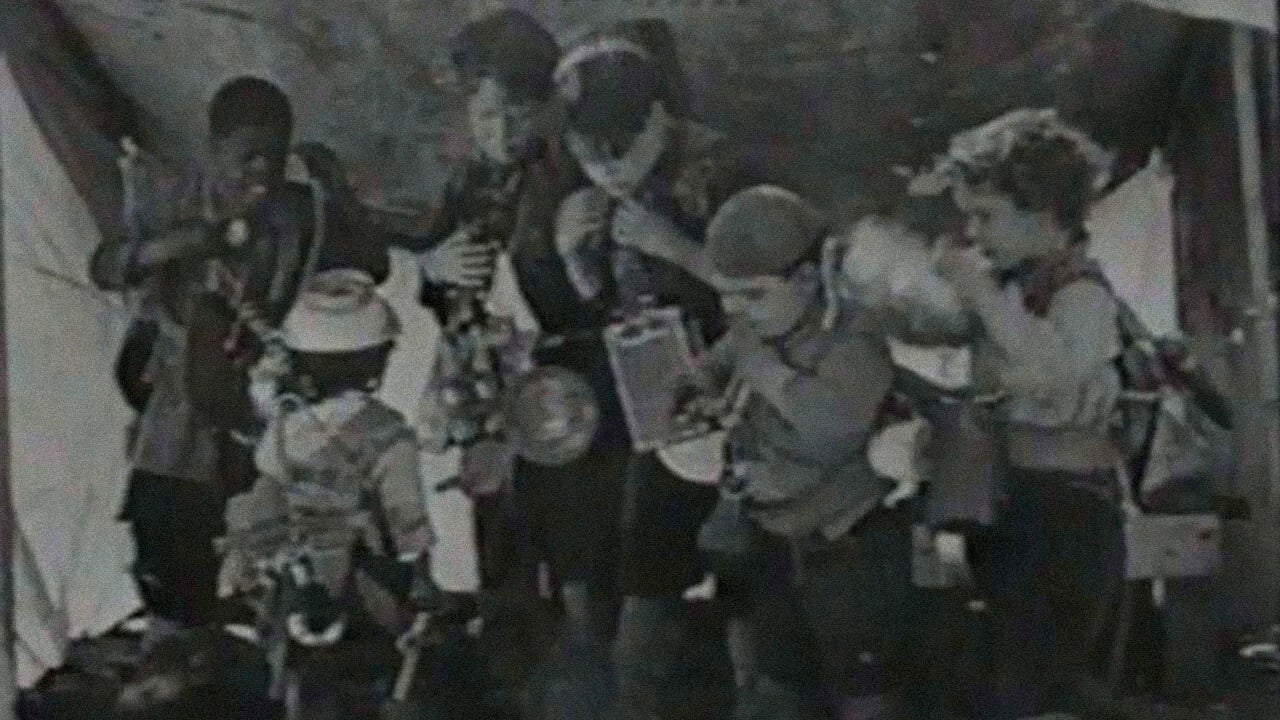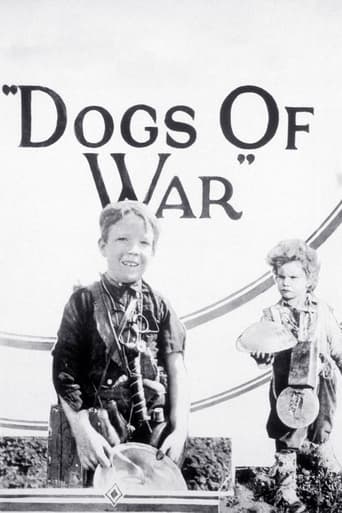

The acting is good, and the firecracker script has some excellent ideas.
... View MoreThe movie's neither hopeful in contrived ways, nor hopeless in different contrived ways. Somehow it manages to be wonderful
... View MoreThe thing I enjoyed most about the film is the fact that it doesn't shy away from being a super-sized-cliche;
... View MoreThere are moments in this movie where the great movie it could've been peek out... They're fleeting, here, but they're worth savoring, and they happen often enough to make it worth your while.
... View MoreOur Gang spoofs the great war in this silent short where they really seem to be on a genuine battlefield, complete with trenches, make-shift tanks and seemingly real bombs. If the bombs don't get em', the smell of skunk will, and it's gas masks for everyone. Then, they end up at a movie studio, creating all sorts of havoc. That segment is much funnier than the opening with the battle sequence. The alleged filming of a silent melodrama is interrupted by the gang who think that the action is real. Basically a pleasing little short, rarely seen today in comparison with the Our Gang talkies. If you ever wondered what Farina's gender was, look no further. It is revealed here.
... View MoreI grew up with the sound incarnations of the Little Rascals and I had never seen a silent one in its entirety until this short. While it has not converted me to a fan of their work, I must admit I liked it far more than the Alfalfa and Spanky-era Rascals. Most of the reason I liked it was because it offered a backstage look at Hal Roach Studios, though in the film the name of the studio was fictionalized. You were given glimpses of the film making process and there was a cute little cameo with Harold Lloyd (who at the time was also working for Roach). According to the DVD case, Harold was working on SAFETY LAST when the Rascals interrupt, but this is clearly wrong. The set is that of his film WHY WORRY?. I think kids might like this movie a little more, but there was enough for adults that I think anyone willing to give a silent short a chance would probably like this film.
... View MoreFor those of us who grew up watching TV in the Cold War era any mention of Our Gang (or "The Little Rascals" as they were known on the tube) summons up memories of Spanky, Darla, Buckwheat, and of course Alfalfa, forever singing off-key in homeroom class. It's the gang of the 1930s and early '40s we remember, since those were the shorts replayed so often in syndication packages, but meanwhile the Our Gang kids of the silent era have been neglected. Many latter-day viewers may not know about the first generation of once-famous rascals, including Mickey Daniels, Joe Cobb, Mary Kornman, "Sunshine Sammy" Morrison, and toddler "Farina" Hoskins. Producer Hal Roach launched the series in 1922, and although the earliest shorts aren't so easy to find they're generally quite enjoyable, and well worth tracking down. The tone is different from the later, more polished talkies; in these silent shorts the kids are scruffier-looking and their adventures are somewhat rougher. Dogs of War, the fourteenth release, is a delightful and unusual comedy that in my opinion ranks with the series' best entries. And although general audiences will certainly enjoy it for its own sake, it's a special treat for movie buffs, rife with inside jokes and layers of meaning.The first portion details the Battle of Kelly's Tomato Patch, i.e. an elaborate game of war between the familiar kids and a rival gang. When these kids play war, they don't mess around: they fight in trenches lined with barbed wire, their officers wear makeshift Doughboy uniforms and helmets, and the "enemy" soldiers wear Kaiser Wilhelm-style spiked helmets. They have lots of toy guns, and for the startling climax they reveal their secret weapon: a home-made tank! Meanwhile, Mary serves as a Red Cross nurse in the Infirmary, and the boys are not above faking injury in order to be treated by her. Although this sequence is funny it works on a darker level, too: the comic battle depicted here is taking place only five years after the Armistice ended the Great War in Europe, and it's a little chilling to watch as these innocent kids lightheartedly re-enact a cataclysm they're too young to remember, and would only have seen in the movies. The sequence moves along briskly with lots of gags without dwelling on any unpleasant matters, but the heavier undercurrent is there.Early on, there's a striking detail for those watching closely: adjacent to Kelly's Tomato Patch, serving as a backdrop of sorts for the children's war game, there is a movie lot labeled the "West Coast Studios." This is in fact the Hal Roach lot, coyly renamed for the occasion, and its undisguised visibility introduces a new element into the mix: we're given to understand that the kids we see in Dogs of War are Hollywood kids, kids who just happen to live and play near a movie studio, where playacting on a much grander scale is taking place all the time. Although it could be said that any children playing soldier in a backyard are like actors in a self-created scenario, here we have kids who are re-enacting a war drama just outside the gates of a factory where such dramas are actually produced -- and of course, these children just happen to be the famous Our Gang kids, playing outside the very studio where they are employed. There's a Pirandello quality to all this (i.e. actors playing actors, in a play-within-a-play) that someone could turn into a dissertation . . . to which the Little Rascals themselves would respond with a resounding raspberry.At any rate, the plot thickens when Mary's mother arrives and takes her daughter off to earn $5 a day as a film actress, and here is where the world of the kids' playacting and the world of the grown-ups' playacting overlaps. After eluding an ineffectual security guard the gang invades the studio, where they dash through sets and ruin takes. They play on a treadmill before a Sennett-style diorama, they are menaced by a man in a bear suit -- a bored actor, I guess -- and then they encounter Mary on the set of a film entitled "Should Husbands Work?" This little epic is a comic highlight, an absurd pastiche of silent melodramas featuring hammy acting and clichéd, disjointed dialog, including a parody of Theda Bara's most famous line: "Kiss me, my Fool!" (Within a couple of years Miss Bara would be working on the Roach lot, satirizing herself in a good-natured fashion.) After they've been banished from the set the kids sneak back and make their own movie, which is then shown with the rushes in the projection room to the assembled studio staff. As in Buster Keaton's The Cameraman of 1928, the kids' accidental opus is a surreal mini-masterpiece of double exposures, visual puns and camera tricks, one final cinematic inside joke in a film full of them. And speaking of great silent comics, there's even a brief cameo by Harold Lloyd, seen on the set of his feature Why Worry?, which happened to be his last collaboration with his long-time producing partner Hal Roach.Dogs of War is an original, a comedy so packed with inventive bits and unexpected twists that it hardly seems possible it's only about twenty minutes long. This is a must-see for silent film buffs, and should provide a pretty good time for non-buffs, too.
... View MoreWith two different but both creative and entertaining sequences, this Our Gang comedy works very well. It features some lively yet believable performances by the young cast, and as a bonus there is also a fun cameo appearance by Harold Lloyd.Both the mock battle scene and the studio scene are full of good material, with some creative props and amusing gags. The mock battle is not only entertaining to watch, but also comes across as just the kind of thing that a group of imaginative children would conceive of. The sequence in the studio is less tightly organized, but it has a good manic pace to it, and it is high-lighted by some clever visual effects.The studio sequence also offers a pleasant, light-hearted look at the movie business, which is typical of this kind of scene in silent comedies. This lack of pretense in the way that many in the industry of the era saw themselves is quite a contrast from the ponderous self-importance of so many of today's film-makers. That could be one of the reasons why you so rarely see such lively, innocently enjoyable comedies like this anymore.
... View More